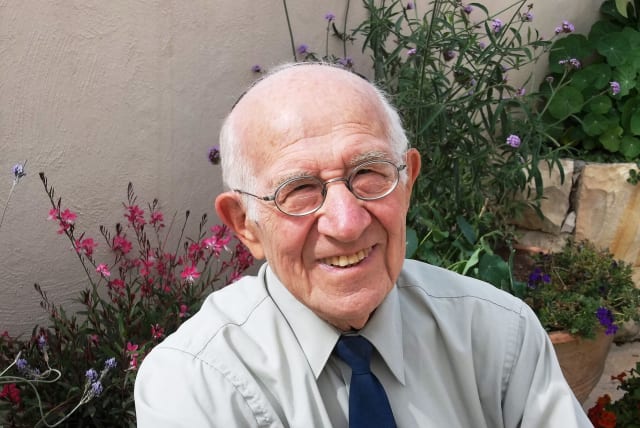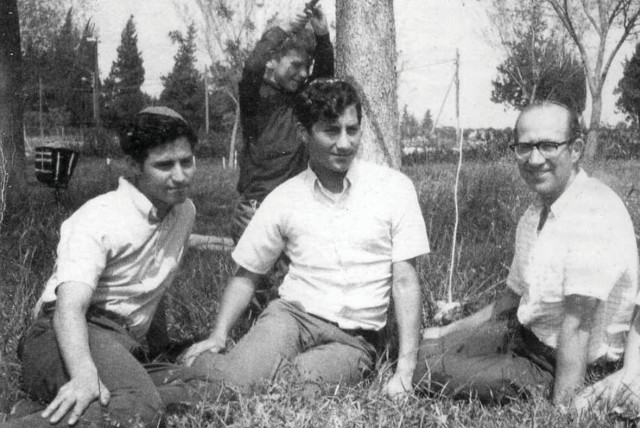The famed Dershowitz family and a story of aliyah to Israel

Rabbi Prof. Zecharia Dor-Shav (Dershowitz) is a retired professor from Bar-Ilan University, an author and speaker, uncle to renowned US lawyer Alan Dershowitz.
Rabbi Prof. Zecharia Dor-Shav (Dershowitz) refers to the interpretation the commentator Onkelos gives of the creation of Adam, “He blew into his nostrils a living soul, and it was for a speaking spirit in man” (Genesis 2:7, Sefaria.org.il).
“Humanity,” says Dor-Shav, “is defined by words, by the capacity for abstract, creative thought.
“Who am I?” he asks. “I am a person of words.”
Dor-Shav is a retired professor from Bar-Ilan University, an author and speaker. His special lecture topics span such themes as the religious absorption of the Ethiopian Jews; the status of the Temple Mount; and relations between the religious and secular communities in Israel.
He believes that the past informs the present and future. In a paper he published at Bar-Ilan, “Ego, Language and Freedom of Choice,” he describes the link between a grasp of history and our freedom to make choices.
“This grasp is necessary so that man can connect events in the far past with those that are current. Free choices that we make today will have consequences that will not be experienced until long after we have departed from this world,” he writes.
With this perspective on history and free will, Dor-Shav wrote his recently published memoir, Dershowitz Family Saga: A Century and a Half of Jewish Life in Poland, through America, and into Israel, seamlessly interconnecting his personal life with the continuing evolution of his people. It is the story of a kinship with Israel and with the world, a converging of autobiography and history, of affinity and adventure.
When the Six Day War broke out in 1967, Dor-Shav had completed a PhD in psychology and education at New York University and was working as a professor of education at Long Island University. Two days after the war had started, while contemplating an offer of employment he had received from the School of Education of Bar-Ilan University, he heard the news that the Old City of Jerusalem had been recaptured. Rabbi Shlomo Goren blew the shofar at the Kotel, the liberated Western Wall, and Dor-Shav recalls the joy he felt hearing that shofar blast in his Brooklyn home. He shouted the words of Isaiah 27:13, “And it shall come to pass on that day, that a great shofar will be blown, and those lost in the land of Assyria and those exiled in the land of Egypt will come and will bow before the Lord on the holy mountain in Jerusalem.”
He remembers immediately going to the Jewish Agency to volunteer his services; but being a rabbi, a psychologist, a school principal, a professor and a first-aid instructor did not impress them. When he told them, however, that he could drive a small bus, they said to him, “Get your passport; we can use you!”
Two years later, in 1969, he made the move. Aliyah was natural for him, a childhood dream, a part of his soul. “Being Jewish means needing Israel,” he says. “This is our home.”
DOR-SHAV SAILED from New York on the Greek ship Queen Anna Maria, with his wife and three sons, together with 200 other olim, and a sefer Torah, a Torah scroll, that had been rescued from the Nazis in Vienna. He relates how his son Simcha Hillel led the family off the ship, carrying the scroll wrapped in a tallit, and how, on the shores of Haifa, a policeman stepped forward to kiss the Torah.
A short while after their arrival, Dor-Shav accepted the position at Bar-Ilan and moved into faculty housing on campus in Ramat Gan. They soon bought a property in Herzliya that was simply a pile of sand, and built their home, the second house north of the Tel Aviv dunes. Eventually, the family moved to the Old City in Jerusalem.
One reason he made aliyah, he says, was to be an educator in Israel. He taught students to think critically and to forge a life-long pursuit of learning. He strove to instill in his students the determination to try paths they would not have had the courage to pursue. At Bar Ilan, Dor-Shav served as director of the Eliezer Stern Institute for the Study and Advancement of Religious Education.
HOW DID the name Dershowitz become Dor-Shav? After making aliyah, while visiting Sde Boker one day, he met David Ben-Gurion, who exclaimed that he should now have a Hebrew name like himself. In time, he changed Dershowitz to Dor-Shav, which translates in a meaningful way to “the generation that returned.”
With a passion for words and possessing an encyclopedic knowledge of Tanach, history, psychology, and Jewish philosophy, Dor-Shav says he felt the need to record “what I remember hearing, reading and personally experiencing during these nine-plus decades that have, until now, been part of my sojourn on Earth.”
In his memoir, he narrates a journey back and forth in time through the lens of memories, iconic historic moments, photographs and the mystery of coincidences.
“I feel humbled by the thought that so many important steps in the advancement of our people from the diaspora of Poland to the Land of our Destiny have been accompanied by actions of members of my family and myself,” he writes.
The history of the Dershowitz family
His nephew, Alan Dershowitz, the acclaimed American lawyer, legal analyst and civil rights advocate, wrote the foreword of the memoir.
Family roots began in Pilzno, Poland. His father, Louis/Leibish Dershowitz, arrived in the US, the Goldene Medina, in 1891, following his own father, Zecharja, who had emigrated in 1888. New York at the beginning of the century is brought to life. His grandfather Zecharja, a Ropshitz Hassid “with modern leanings, which is to say that he dressed in modern garb,” worked for the Triangle Shirtwaist Factory and, as fate had it, did not go to work on that Sabbath day of the disastrous fire in 1911. Dor-Shav describes the garment industry’s sweatshops that were open six days a week, including the Sabbath, and notes there were many devout people of hassidic, Galician background who had to change employers every week. His father, he writes with pride, envisioned and was the prime instrument in the founding of the Yeshiva and Mesivta Torah Vodaath in Williamsburg in 1918.
He tells of the New York World’s Fair of 1939-1940, and the moment when on Monday, August 6, 1945, he left the bowling alley and read the headline at a newspaper stand that an atomic bomb was dropped over the city of Hiroshima.
“In a sense,” he writes, “my generation mirrors the generation of Ezra and Nechemiah that built the Second Temple, and bridged the period from the First to the Second Temples. Great tragedies were followed by great advancements.”
Dor-Shav illuminates the birth and early life of Israel and the formidable heroes who built the country. The mystic-nationalist Rav Avraham Yitzhak Kook emphasized, “... the Jewish nation is only fully in tune with its own spirit when living in Israel, its organic source.”
The “Father of Prisoners,” Rabbi Aryeh Levin, of the Etz Chaim Yeshiva, faithfully visited members of the Jewish underground imprisoned in the Russian Compound in Jerusalem and also assisted the sick and the poor. Rabbi Moshe Zvi Segal continued to defy the British ban on blowing the shofar on Yom Kippur at the Western Wall but found a creative way to ensure that the shofar would be blown every year. With a sense of gratefulness, Dor-Shav describes his personal experiences with the great rabbis of his generation.
Rabbi Yitzchak Hutner, his rebbe, was among the kidnapped passengers of the Dawson’s Field hijackings of September 6, 1970, in which the Popular Front for the Liberation of Palestine hijacked three civilian aircraft, en route to the US, to the desert strip in Jordan and forced them to land.
Oslo, Stockholm, New York, Moscow, São Paulo, Manaus, Sydney, Tokyo, Hong Kong, Xi’an, Beijing. Sabbaticals and travels were opportunities for Dor-Shav to immerse in other cultures and to form relationships with people all over the world. He shares anecdotes and pays tribute to his doctoral mentor and friend Margaret Mead and her daughter, Mary Catherine Bateson, both cultural anthropologists.
In Moscow in 1993, he witnessed “the shattering of the Soviet Union.” In Brazil in 2005, he met with and learned about the Anusim – Jews who were forced to abandon Judaism.
Whenever and wherever there is an opportunity, Dor-Shav participates with compassion. During the 1973 Yom Kippur War, he volunteered in the Rehabilitation Ward of Tel Hashomer Hospital and is haunted by images of the suffering and struggles of the wounded soldiers. As well, he was personally involved in the rescue and absorption of the Beta Israel Ethiopians and worked closely with the American Association for Ethiopian Jews to obtain passports and visas to the US and then on to Israel.
It is Israel, Dor-Shav believes, that stands at the crossroads of the world.
Therefore, I ask him, “What is the lesson we should learn from history?”
He is hopeful. In one of his publications, he intricately describes the midrashic commentary on the congregation of Israel as portrayed in Numbers 2:2, “The children of Israel shall encamp each man by his division with the flag staff of their father’s house...”
The Israelite encampment in the desert parallels the four-sided plan of the world as described in Isaiah 11:12, “He shall gather from the four corners of the Earth.”
Each tribe encircled and encamped around the Mishkan, the Tabernacle, organized in concentric circles, three tribes in each of the four directions, each holding its tribal flag, distinct in color, symbolic imagery and identity. They all uniquely contributed, interacted and complemented one another.
“In this same manner, we have a possibility to live in peace with one another,” reflects Zecharia Dor-Shav, with optimism.
“When you reach my age,” he says, “am I thinking about today or tomorrow? Life is a trial period, a short period of eternity during which we are faced with the trial of picking the right paths a million times a day.” ■
Dershowitz Family Saga: A Century and a Half of Jewish Life in Poland, through America, and into Israel is available at Book Depository and Amazon.
Zecharia Dor-Shav (Dershowitz) From New York to Jerusalem, 1969
Jerusalem Post Store
`; document.getElementById("linkPremium").innerHTML = cont; var divWithLink = document.getElementById("premium-link"); if (divWithLink !== null && divWithLink !== 'undefined') { divWithLink.style.border = "solid 1px #cb0f3e"; divWithLink.style.textAlign = "center"; divWithLink.style.marginBottom = "15px"; divWithLink.style.marginTop = "15px"; divWithLink.style.width = "100%"; divWithLink.style.backgroundColor = "#122952"; divWithLink.style.color = "#ffffff"; divWithLink.style.lineHeight = "1.5"; } } (function (v, i) { });

